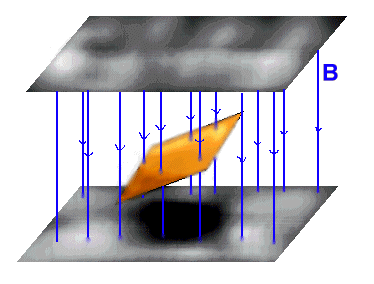Introduction
to induction:
Magnetic flux is
a term for the density of a magnetic field. Flux is measured by a
unit called a weber (wb), which is a tesla x a square meter.
Flux is proportional to the number of magnetic field lines passing through
a surface.

Flux is the number of magnetic field lines passing through a surface.
As you can see in the diagram, this depends on both the strength of the
magnetic field (stronger field = more lines = larger flux) and the size
of the surface (larger surface = more lines = larger flux).
When the flux through a surface
changes, an electromotive force (emf - and not really a vector force
as we know it) is induced. This induced emf
causes induced current.
As long as the magnetic field is
changing, a current is induced. The induced current is always in such a
direction as to keep the magnetic field constant. The emf
induced in a circuit is directly proportional to the time rate of change
of magnetic flux through the circuit. Basically this means that the induced
emf is directly related to magnetic flux as a function of time.

Lenz's Law states that the polarity
of an induced emf will produce a current that creates a magnetic flux that
opposes the change in magnetic flux through the loop formed by the circuit.
The induced current opposes any change in magnetic flux.
That is to say, the induced current
must be in a direction so that the flux it produces opposes the change
in the external (applied) magnetic flux. For example, if a bar moves to
the right, then the induced current would be counterclockwise so that the
force produced is directed towards the left.
There. A brief overview of flux and induced current.
Move on to Project, Part A
Or go back to the contents.
